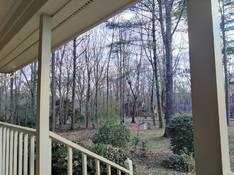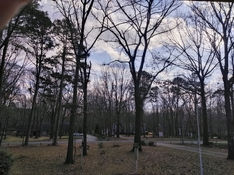Sitting out on my front porch on a not so cold, overcast winter Sunday, I got out my R72 filter just to play with it. Being such a dark filter, you have to put it up to your eye and give your eye a little time to adjust, to see anything. What I saw surprised me. Look at these 2 cell phone photos. Those areas of blue sky are not that blue at all in person. It's actually a rather dull day. If I were to shoot a scenic of a cornfield or something on a day like this, a No 8 yellow filter would do nothing. I'd still have a white sky in the B&W photo. Same with a No 11. I bet even a 25A red filter would give me nearly zilch in cloud separation. But even with that barely-there shade of blue, the R72 knocked that blue right out. It wasn't black, of course, but everything was totally different. Brilliant white clouds, dark sky. Very picturesque.
An R72 is for infrared film. But what would happen if you went out shooting scenics on normal pan film with it? Especially on a sunny day in early spring where all the new leaves are full of chlorophyll. I bet a normal roll of pan film would be turned into have normal/half infrared. Or would it?
An R72 is for infrared film. But what would happen if you went out shooting scenics on normal pan film with it? Especially on a sunny day in early spring where all the new leaves are full of chlorophyll. I bet a normal roll of pan film would be turned into have normal/half infrared. Or would it?














